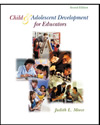 |  Child and Adolescent Development for Educators, 2/e Judith Meece,
University of North Carolina - Chapel Hill
Student Study Guide by Nancy Defrates-Densch
Peer Relations and Moral Development
Learning ObjectivesAfter study of this chapter, you should be able to:
| Describe the development of children's abilities to understand the perspective of others. |
 |  |  | | Describe age-related differences in how children describe other people. |
 |  |  | | Describe the development of children's understanding of race and ethnicity. |
 |  |  | | Identify some positive and negative influences of peers on children's development. |
 |  |  | | Identify characteristics of children who are popular, neglected, and rejected, and explain how teachers can promote positive peer relations in the classroom. |
 |  |  | | Explain how parents and teachers can foster the development of prosocial behaviors in children. |
 |  |  | | Describe different forms of aggression, discuss possible causes of childhood aggression, and explain what can be done at school to reduce aggression. |
 |  |  | | Describe developmental changes in peer relations from infancy through adolescence. |
 |  |  | | Identify difficulties with peer relationships experienced by gay and lesbian youths. |
 |  |  | | Describe Kohlberg's theory of moral development and identify links between moral reasoning and behavior. |
 |  |  | | Describe Nel Nodding's ethic of care and identify what educators can do to create a moral community in the classroom. |
|



 2002 McGraw-Hill Higher Education
2002 McGraw-Hill Higher Education